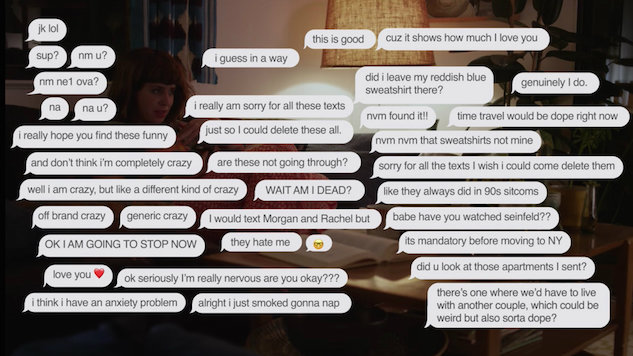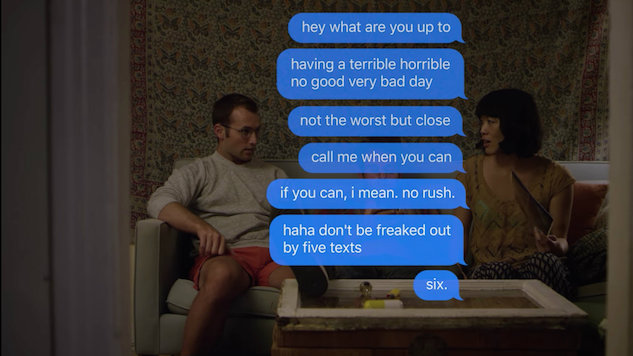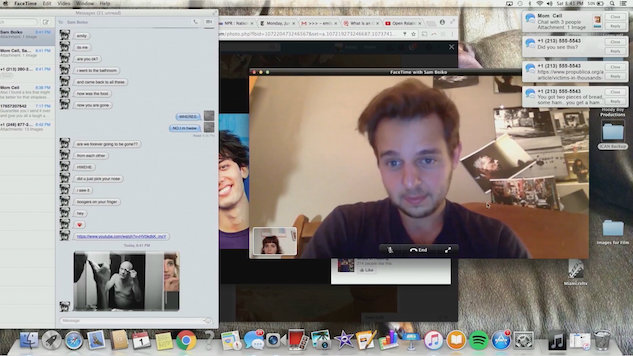Alex Dobrenko’s Distance Shows That Sometimes the Internet Can Still Produce Magic
TV Features Distance
It goes this way: You throw yourself on your couch, or your bed, or, if a snoozing dog is there ready for some love, on your floor. You open a third or thirteenth or thirtieth tab in your browser and start typing in the name of the website, autofill meeting you halfway. You scroll down the page, and there’s the first episode, waiting for you to hit play. Next to it, of course, is the first episode, waiting for you to hit play.
You hit play. The episode runs, ends, offers you Episode 2. Or, alternatively, Episode 2. Or, alternatively-alternatively, Episode 1, but the other one, the one you didn’t pick the first time.
You hit play again.
And now, you are watching a show I have never seen. Or at least, probably you are, because with Alex Dobrenko’s new interactive web series, Distance, the Episode 1 I started with has only a 50:50 chance of being the Episode 1 you started with.
Maybe, like me, you decide to watch Emily’s (Ashley Rae Spillers) side of Episode 1 first (directed by Carlyn Hudson). But just as possibly, you decide to start with the Episode 1 (directed by Jack Lawrence Mayer) told from the perspective of her long-distance boyfriend, Sam (Dobrenko). And then what? Maybe you keep watching Sam’s side. Or maybe you keep watching Emily’s. Or maybe you switch back and forth. Or maybe you switch forth and back. Maybe you watch all of one side of the story first, then move on to the second. Maybe you do a bit of everything, following your gut as each short episode ends.
It doesn’t really matter what exact path you take, or which one I followed. By the time we each reach Episode 6, we will have both seen all the same shots, experienced all the same highs and lows, watched Emily and Sam navigate the same days and moments and conversations from their two unique perspectives. The cumulative effect, though—how it all stacks together in our brains to form a cohesive whole—will be completely different. Not only will you have watched a show I have never seen, but you will have watched one I never can see.
Which is exactly Distance’s point. This interactive, dual-perspective approach is not a gimmick, but a framing device integral to the experience the show is interrogating: A relationship may take two people to function, but both of those people are individuals with their own personalities and goals and blind spots and just, like, day-to-day life shit threatening to distract them at any given moment, so while there will be two people in the relationship, their experiences of it will be entirely distinct. Lots of modern storytelling takes this tension on, but what Distance does, living in its endlessly variable video collection on its own web page rather than locked into a single linear story on a traditional streaming site, is open the tension up to be viscerally, physically engaged by the audience.
“Knowing it would live online meant we could create whatever watching experience we wanted,” Dobrenko tells Paste. “So we said, ‘Let’s do it, let’s lean into this whole two perspective thing.’ From there, it quickly became clear we should have two directors, one a female and one a male, to represent the two characters and sides. Then there were three visions for the show—mine as the creator, Jack’s as what he saw Sam and his world to be, and Carlyn and what she saw Emily and her world to be.”
As seamless as the final product came out, though, sticking the landing on the Big Interactive Idea wasn’t a given.
“At first thought, [the two-episode engine] seems like a great idea, but the more you dive in, the harder it gets,” Dobrenko explains. “We had to answer so many questions—how different do you make it, how aware of the other side should each director be, how much should we improvise, etc. The questions morphed from logistical production questions to philosophical ones—how does perspective work, is there really any such thing as an objective experience?”
On the logistical side, at least, there was a quick answer: To maintain the separation of the project’s three distinct visions, the two sets were kept independent from one another until Episode 6, which Hudson and Mayer co-directed. They shared a production team (and Dobrenko in the showrunning role), but were otherwise left to make their own creative choices—a process which had its pluses and minuses.
Emily episode, directed by Hudson

Sam episode, directed by Mayer

“Jack and I have a lot of the same references as filmmakers and definitely trust each other’s taste,” Hudson explains, “[so] we felt free to direct completely independently of one another.”
Throwing all the shine his directors’ way, Dobrenko adds, “Jack and Carlyn have such different directing styles, too, so it was so cool to see how the two of them would handle the same exact scene—from the lighting, to the mood, to the makeup and clothes, all of these little differences combine to create a subjective experience. As someone who is mainly an actor and writer, watching Jack and Carlyn both direct was a great crash course in how each of the different elements—tone, lighting, production design, music, etc.—can influence a moment.”
That said, the separate sets, and all the arcane, lived-in details of the technology Emily and Sam and all the rest of us use to connect in 2018 presented plenty of challenges. Hudson notes how demanding it was to get the series’ few shared scenes to match up in a way that looked different in artistic ways, and not like mistakes.
“Moments that were too different skewed hokey and unrealistic, but moments that were too similar and subtle sometimes felt like a filmmaking mistake rather than a purposeful one,” she says. “Finding that balance was key, and not always easy.”
For Mayer, it was filming the video calls live that was the biggest challenge. “Alex and Ashley have such awesome chemistry together that neither of them can stay on script even if they wanted to,” he explains. “There’s such a flow of conversation and real-time reactions between the two of them. So it was important to us to find a way to capture the live performance despite the fucking myriad of technical reasons not to film a video call live (for instance, the risk that our only audio from one side was in fact coming out of a real laptop speaker). But setting up two sets simultaneously and directing one actor remotely, while also factoring in wifi connection, audio and video needs—and then shooting the same scene on a different day at the other location with another director so that each director could have full control over their set—the logistics made all of our brains fuzz over. But damn, was it worth it to get the real performance.”
Getting those performances right was damn important—the video calls, like every other identifying feature of Distance, aren’t gimmick, but subject. They are basically the only way Emily and Sam interact, both when they want to do so with intentionality (the awkwardly failing cybersex of Episodes 2), and when the call is little more than background noise (Episodes 4, where they are but tiny videos layered deep in each others’ migraine-inducingly busy desktops). They are the core of the whole project. They are the endlessly embedded windows through which the philosophical questions about what perspective is and if objectivity is real might be answered.

Given the indefinite note on which the series’ first season ends—and the fact that I couldn’t get anyone on the production side to declare a definitive “Director’s Cut” order of viewing—the answer to the latter, at least, seems to be no.
“I mean… all of Emily’s sides first because girls rule?” Hudson jokes.
“We’ve had a lot of people tell us that they’ve watched all of Sam’s side, then all of Emily’s side,” Dobrenko notes. “That’s so rad. You couldn’t do that on TV.”
For Mayer, whose background in the immersive audience experiences of live theater strongly influenced his approach to the project, the answer to objectivity-via-Director’s-Cut is an emphatic no, and speaks further to the question of what perspective signifies in the first place.
“The thing that gets me so excited about the series,” he explains, “is the chaotic potential of all the different combinations—and the personalities of the audience members that lead them to their order. I fucking love not having control over that.”
This is an attitude we could all probably do to emulate—both in watching out favorite shows (linear and not), and in working through the chaotic potential of our own relationships.
In the meantime, there is the lovely, artful Distance, and all its innumerable possibilities, hinting at what modes of storytelling there may yet be untapped, even in this glut of Peak TV.
Distance is now streaming, in whatever iteration you choose.
Alexis Gunderson is a TV critic whose writing has appeared on Forever Young Adult, Screener, and Birth.Movies.Death. She’ll go ten rounds fighting for teens and intelligently executed genre fare to be taken seriously by pop culture. She can be found @AlexisKG.